 Triumph Street Triple S - Owner's Manual > Brakes
Triumph Street Triple S - Owner's Manual > Brakes
Breaking-in New Brake Pads and Discs
Warning: Brake pads must always be replaced as a wheel set. At the front, where two calipers are installed on the same wheel, replace all the brake pads in both calipers.
Replacing individual pads will reduce braking efficiency and may cause an accident.
After replacement brake pads have been installed, ride with extreme caution until the new pads have 'broken in'.
New brake discs and pads require a period of careful breaking-in that will optimize the performance and longevity of the discs and pads. The recommended distance for breaking-in new pads and discs is 200 miles (300 km).
During this period, avoid extreme braking, ride with caution and allow for greater braking distances.
Breaking-in New Brake Pads and Discs
Warning: Brake pads must always be replaced as a wheel set. At the front, where two calipers are installed on the same wheel, replace all the brake pads in both calipers.
Replacing individual pads will reduce braking efficiency and may cause an accident.
After replacement brake pads have been installed, ride with extreme caution until the new pads have 'broken in'.
New brake discs and pads require a period of careful breaking-in that will optimize the performance and longevity of the discs and pads. The recommended distance for breaking-in new pads and discs is 200 miles (300 km).
During this period, avoid extreme braking, ride with caution and allow for greater braking distances.
Front Brake Wear Inspection
Warning: If installing new proprietary brand brake pads, check that the carrier plate of the brake pad is the specified thickness shown in the table.
Installing brake pads with the carrier plate less than the specified thickness may result in brake failure due to the possible loss of the brake pad as it wears.
Brake pads must be inspected in accordance with scheduled requirements and replaced if worn to, or beyond the minimum service thickness.

- Carrier plate
- Brake pad
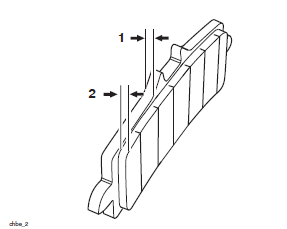
- Carrier plate
- Brake pad lining
Brake pads for this model supplied by Triumph will have the carrier plate at the recommended thickness. Always have replacement brake pads supplied and installed by your Triumph dealer.
If the lining thickness of any brake pad is less than that specified in the table, replace all the brake pads on the wheel.

Rear Brake Wear Inspection
Warning: If installing new proprietary brand brake pads, check that the carrier plate of the brake pad is the specified thickness shown in the table.
Installing brake pads with the carrier plate less than the specified thickness may result in brake failure due to the possible loss of the brake pad as it wears.
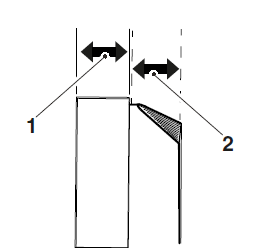
- Carrier plate
- Brake pad lining
Brake pads supplied by Triumph will have the carrier plate at the recommended thickness. Always have replacement brake pads supplied and installed by your Triumph dealer.
If the lining thickness of any brake pad is less than that specified in the table, replace all the brake pads on the wheel.
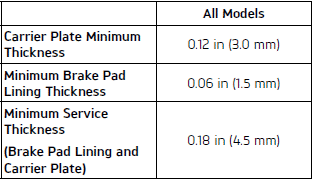
Disc Brake Fluid
Warning: Brake fluid is hygroscopic which means it will absorb moisture from the air.
Any absorbed moisture will greatly reduce the boiling point of the brake fluid causing a reduction in braking efficiency.
Because of this, always replace brake fluid in accordance with scheduled maintenance requirements.
Always use new brake fluid from a sealed container and never use fluid from an unsealed container or from one which has been previously opened.
Do not mix different brands or grades of brake fluid.
Check for fluid leakage around brake installed, seals and joints and also check the brake hoses for splits, deterioration and damage.
Always rectify any faults before riding.
Failure to observe and act upon any of these items may cause a dangerous riding condition leading to loss of control and an accident.
Warning: If the ABS is not functioning, the brake system will continue to function as a non-ABS equipped brake system.
In this situation, braking too hard will cause the wheels to lock resulting in loss of control and an accident.
Reduce speed and do not continue to ride for longer than is necessary with the indicator light illuminated. Contact an authorized Triumph dealer as soon as possible to have the fault checked and rectified.
Inspect the level of brake fluid in both reservoirs and change the brake fluid in accordance with scheduled maintenance requirements. Use only DOT 4 fluid as recommended in the Specification section. The brake fluid must also be changed if it becomes, or is suspected of having become contaminated with moisture or any other contaminants.
Note: A special tool is required to bleed the ABS braking system. Contact your authorized Triumph dealer when the brake fluid needs replacing or the hydraulic system requires maintenance.
Front Brake Fluid Level Inspection and Adjustment
Street Triple RS
Warning: If there has been an appreciable drop in the level of the fluid in either fluid reservoir, consult your authorized Triumph dealer for advice before riding.
Riding with depleted brake fluid levels, or with a brake fluid leak is dangerous and will cause reduced brake performance potentially leading to loss of motorcycle control and an accident.
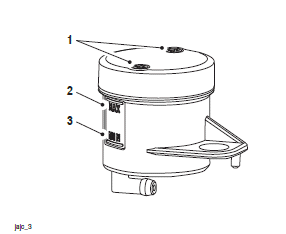
- Reservoir cap retaining screws
- MAX level line
- MIN level line
To inspect the front brake fluid level:
- Check the level of brake fluid visible in the MIN and MAX section of the reservoir.
- The brake fluid level in the reservoir must be kept between the MAX and MIN level lines (reservoir held horizontal).
To adjust the brake fluid level:
- Loosen the reservoir cap retaining screws and remove the reservoir cap and the diaphragm seal.
- Fill the reservoir to the MAX level line using new DOT 4 brake fluid from a sealed container.
- Install the diaphragm seal into the reservoir cap and make sure that the holes for the fasteners in the reservoir cap and the diaphragm seal are correctly aligned.
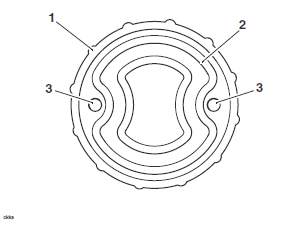
- Reservoir cap
- Diaphragm seal
- Reservoir cap retaining screw holes
- Install the reservoir cap retaining screws into the reservoir cap and diaphragm seal assembly.
- Hold the assembly together and position the reservoir cap, diaphragm seal and reservoir cap retaining screws onto the reservoir.
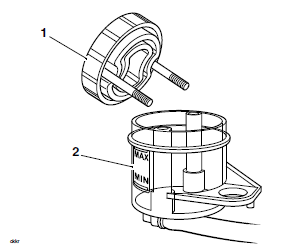
- Reservoir cap, diaphragm seal and reservoir cap retaining screws assembly
- Reservoir
Warning: If the reservoir cap retaining screws are over tightened this can result in a brake fluid leak.
A dangerous riding condition leading to loss of motorcycle control and an accident could result if this warning is ignored.
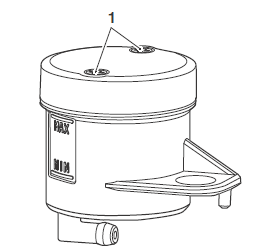
- Reservoir cap retaining screws
- Tighten the reservoir cap retaining screws to 6 lbf in (0.7 Nm).
Front Brake Fluid Level Inspection and Adjustment
All Models except Street Triple RS
Warning: If there has been an appreciable drop in the level of the fluid in either fluid reservoir, consult your authorized Triumph dealer for advice before riding.
Riding with depleted brake fluid levels, or with a brake fluid leak is dangerous and will cause reduced brake performance potentially leading to loss of motorcycle control and an accident.
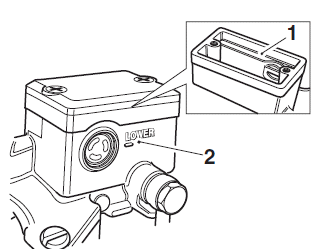
- Front brake fluid reservoir, upper level line
- Lower level line
To inspect the front brake fluid level:
- Check the level of brake fluid visible in the window at the front of the reservoir unit.
- The brake fluid level must be kept between the upper and lower level lines (reservoir held horizontal).
To adjust the brake fluid level:
- Loosen the reservoir cap retaining screws and remove the reservoir cap and the diaphragm seal.
- Fill the reservoir to the upper level line using new DOT 4 from a sealed container.
- Reinstall the reservoir cap making sure that the diaphragm seal is correctly positioned between the reservoir cap and the reservoir body.
- Tighten the reservoir cap retaining screws to 9 lbf in (1 Nm).
Rear Brake Fluid Level Inspection and Adjustment
Warning: If there has been an appreciable drop in the level of the fluid in either fluid reservoir, consult your authorized Triumph dealer for advice before riding.
Riding with depleted brake fluid levels, or with a brake fluid leak is dangerous and will cause reduced brake performance potentially leading to loss of motorcycle control and an accident.
The reservoir is visible from the right hand side of the motorcycle, forward of the muffler, below the rider's seat.
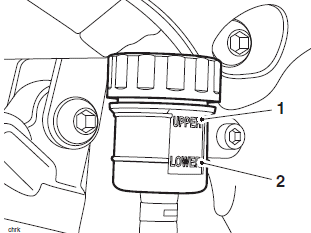
- Upper level line
- Lower level line
To inspect the rear brake fluid level:
- Check the level of brake fluid visible in the reservoir.
- The brake fluid level must be kept between the upper and lower level lines (reservoir held horizontal).
To adjust the rear brake fluid level:
- Loosen the reservoir cap and remove the diaphragm seal.
- Fill the reservoir to the upper level line using new DOT 4 brake fluid from a sealed container.
- Re-install the reservoir cap making sure that the diaphragm seal is correctly installed.
Brake Light Switches
Warning: Riding the motorcycle with defective brake lights is illegal and dangerous.
An accident causing injury to the rider and other road users may result from use of a motorcycle with defective brake lights.
The brake light is activated independently by either the front or rear brake. If, with the ignition in the ON position, the brake light does not work when the front brake lever is pulled or the rear brake pedal is pressed, have your authorized Triumph dealer investigate and rectify the fault.
Mirrors
Warning: Operation of the motorcycle with incorrectly adjusted mirrors is dangerous.
Operation of the motorcycle with incorrectly adjusted mirrors will result in loss of vision to the rear of the motorcycle. It is dangerous to ride a motorcycle without sufficient rearward vision.
Always adjust the mirrors to provide sufficient rearward vision before riding the motorcycle.
Warning: Never attempt to clean or adjust mirrors while riding the motorcycle.
Removal of the rider's hands from the handlebars while riding the motorcycle will diminish the ability of the rider to maintain control of the motorcycle.
Attempting to clean or adjust mirrors while riding the motorcycle may result in loss of control of the motorcycle and an accident.
Only attempt to clean or adjust the mirrors while stationary.
Models with Bar End Mirrors
Warning: Incorrect adjustment of the bar end mirrors may cause the mirror arm to contact the fuel tank, brake or clutch levers or other parts of the motorcycle.
This will restrict brake or clutch lever operation or restrict steering movement, resulting in loss of motorcycle control and an accident.
Adjust the mirrors as required to make sure they do not contact any part of the motorcycle. After adjustment, move the handlebar to the left and right full lock while checking that the mirrors do not contact the fuel tank, brake or clutch levers or other parts of the motorcycle.
Caution: Incorrect adjustment of the bar end mirrors may cause the mirror arm to contact the fuel tank, brake or clutch levers or other parts of the motorcycle.
This will result in damage to the fuel tank, brake or clutch levers or other parts of the motorcycle.
Adjust the mirrors as required to make sure they do not contact any part of the motorcycle. After adjustment, move the handlebar to the left and right full lock while checking that the mirrors do not contact the fuel tank, brake or clutch levers or other parts of the motorcycle.
The bar end mirrors will be set by your authorized Triumph dealer and will not normally require any adjustment. Should adjustment be necessary, do not rotate the mirror beyond 75º, measured from the vertical section of the mirror arm.
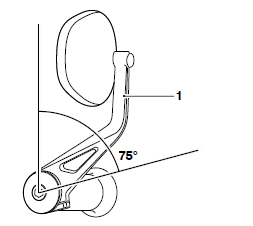
- Mirror arm vertical section
Steering
Caution: To prevent risk of injury from the motorcycle falling during the inspection, make sure that the motorcycle is stabilized and secured on a suitable support.
Do not exert extreme force against each wheel or rock each wheel vigorously as this may cause the motorcycle to become unstable and cause injury by falling from its support.
Make sure that the position of the support block will not cause damage to the motorcycle.
Steering Inspection
Warning: Riding the motorcycle with incorrectly adjusted or defective steering head bearings is dangerous and may cause loss of motorcycle control and an accident.

Inspecting the Steering for Free Play
To inspect the steering:
- Position the motorcycle on level ground, in an upright position.
- Raise the front wheel above the ground and support the motorcycle.
- Standing at the front of the motorcycle, hold the lower end of the front forks outer tube and try to move them forward and backward.
- If any free play can be detected in the steering head bearings, ask your authorized Triumph dealer to inspect and rectify any faults before riding.
- Remove the support and place the motorcycle on the side stand.
Wheel Bearings Inspection
Warning: Riding with worn or damaged front or rear wheel bearings is dangerous and may cause impaired handling and instability leading to an accident.
If in doubt, have the motorcycle inspected by an authorized Triumph dealer before riding.
The wheel bearings must be inspected at the intervals specified in the scheduled maintenance chart.
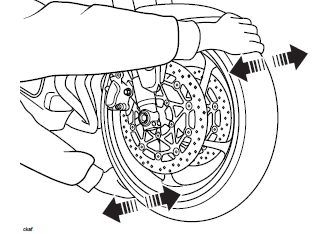
Inspecting the Wheel Bearings
To inspect the wheel bearings:
- Position the motorcycle on level ground, in an upright position.
- Raise the front wheel off the ground and support the motorcycle.
- Standing at the side of the motorcycle, gently rock the top of the front wheel from side to side.
- If any free play can be detected, ask your authorized Triumph dealer to inspect and rectify any faults before riding.
- Reposition the lifting device and repeat the procedure for the rear wheel.
- Remove the support and place the motorcycle on the side stand.
Note: If the wheel bearings in the front or rear wheel allow play in the wheel hub, are noisy, or if the wheel does not turn smoothly, have your authorized Triumph dealer inspect the wheel bearings.
Front Fork Inspection
Warning: Riding the motorcycle with defective or damaged suspension is dangerous and may lead to loss of control and an accident.
Warning: Never attempt to dismantle any part of the suspension units All suspension units contain pressurized oil.
Skin and eye damage can result from contact with the pressurized oil.
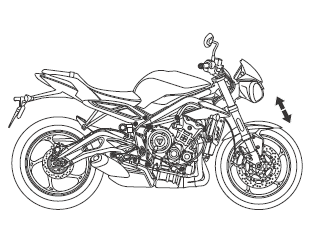
Street Triple S (40.2 cu in (660 cc) ) shown
To inspect the forks:
- Position the motorcycle on level ground.
- While holding the handlebars and applying the front brake, pump the forks up and down several times.
- If roughness or excessive stiffness is detected, consult your authorized Triumph dealer.
- Examine each fork for any sign of damage, scratching of the slider surface, or for oil leaks.
- If any damage or leakage is found, consult an authorized Triumph dealer.
See also:
 Triumph Street Triple S - Owner's Manual > Cooling System
Triumph Street Triple S - Owner's Manual > Cooling System
To ensure efficient engine cooling, check the coolant level each day before riding the motorcycle, and top off the coolant if the level is low.
 Triumph Street Triple S - Owner's Manual > Suspension
Triumph Street Triple S - Owner's Manual > Suspension
Front Suspension Warning: Make sure that the correct balance between front and rear suspension is maintained. Suspension imbalance could significantly change handling characteristics leading to loss of control and an accident.

 Benelli Imperiale 400
Benelli Imperiale 400 BMW F900XR
BMW F900XR Honda CB500X
Honda CB500X KTM 390 Adventure
KTM 390 Adventure Triumph Street Triple S
Triumph Street Triple S Yamaha MT-03
Yamaha MT-03 Kawasaki Z400
Kawasaki Z400 Triumph Street Triple S
Triumph Street Triple S Yamaha MT-03
Yamaha MT-03